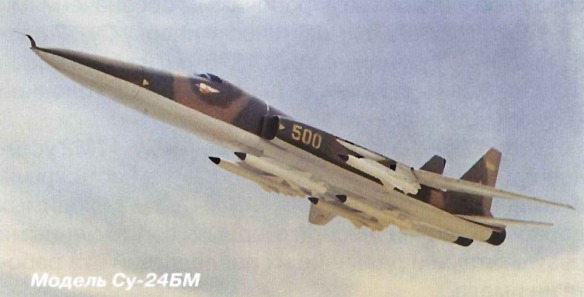
In 1979 V Sarov started work on a much larger development of the Su-24M which had an internal weapons bay that could hold most of the weapons intended to be used by the new aircraft. Known within the OKB as the T-6BM (Bolshaya Modifikatsiya or large modification), and to the W S as the Su-24BM, this was a much bigger aeroplane than the Su-24. The weapons bay was located between the engines and the shortened engine air intake channels allowed the intakes themselves to be located below the wings under the wing roots in a similar way to the American General Dynamics F-111; tandem main wheels were also introduced. As the design progressed and the overall weight increased, concern grew as to whether a strong enough wing swivel mechanism could be designed within the specified weight limit. Theoretically it was possible to produce such a mechanism that would work effectively but, with the types of engine currently available, the resulting aircraft may have been too heavy to take-off. The Su-24BM was intended to replace Tupolev’s Tu-22M3.
General Designer Pavel Sukhoi died in 1975 and his deputy Yevgeny Ivanov was not confirmed as his successor as until 1977. In 1979 the bureau’s Mikhail Simonov was seconded to the Ministry of Aircraft Industry as Deputy to Minister Ivan Silaev and, while there, Simonov was impressed by TsAGI’s suggestion that the Sukhoi T-4 could be developed into a long-range missile carrier (with the designation T-4MS). Following Ivanov’s decision to retire at the age of 72, Simonov returned to Sukhoi as General Designer in 1983 and he instructed a team to start a new project called the T-60S, which was to be a supersonic medium range bomber based on the T-4MS. Thus there were now two project teams within the OKB competing to create the Tu-22M3’s replacement – the Su-24BM based on the Su-24M and the T-60S based on the T-4. Powered by two new turbofans mounted above the rear fuselage as on the original Tupolev Tu-22, the T-60S had a delta wing instead of a swing-wing. Canards were fitted just ahead of the wing and the new design was described as ‘stealthy’.
Supporters of the Su-24BM were aware of the TsAGI proposal and came to the conclusion that a radical redesign was needed if they were to win the internal OKB competition. A new layout was sketched out that showed fixed-geometry wings with large leading edge extensions, which allowed the troublesome variable geometry wing to be dropped, plus a twin tail unit and also the state-of-the-arts avionics suite destined for the T-60S. In 1983, representatives of the WS and Ministry of Aircraft Industry accepted the Su-24BM full-scale mock-up and authorised the OKB to proceed with the design but, by this time, the rival T-60S team were slowly but surely gaining ground; in due course, more resources were moved onto this more advanced project. However the Su-24BM was not terminated until the President of the new Russian Federation, Boris Yeltsin, stopped all work on it in 1992.
The dissolution of the Soviet Union in 1991 and the subsequent economic problems that followed resulted in a hiatus in military aircraft production; this situation was, undoubtedly, also a factor in the decision to abandon the Su-24BM. Since funds were scarce and likely to remain so for some time, plans for the Tu-22M3 replacement were delayed. In addition, nothing further has been heard of the T-60S, so it can only be assumed that either this project suffered the same fate as the Su-24BM or that work continues in great secrecy. Approximate dimensions for the VG Su-24BM were span with wings in the minimum sweep position 37ft 5in (11.40m), at maximum sweep 61ft 10in (18.84m) and length 78ft 11 1/2in (24.07m). The model shows a single air-to-air missile and two air-to-surface missiles beneath each wing and two rear-facing defensive cannon in the end fuselage.